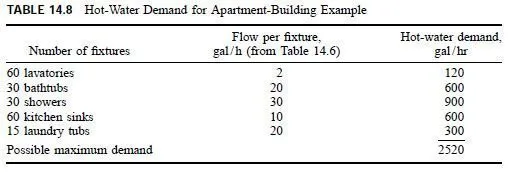There are three main types of wastewater: domestic, storm, and industrial. Separate plumbing systems are generally required for each type.
Domestic wastewater is primarily spent water from the building water supply, to which is added wastes from bathrooms, kitchens, and laundries. It generally can be disposed of by discharge into a municipal sanitary sewer, if one is available.
Storm water is primarily the water that runs off the roof or the site of the building. The water usually is directed to roof drains or gutters. These then feed the water to drainpipes, which convey it to a municipal or private storm-water sewer system. Special conditions at some building sites, such as large paved areas or steep slopes, may require the capture of storm water in retention areas or ponds to prevent the municipal storm sewer systems from being overloaded. From these areas or ponds, the storm water is generally conveyed to the storm sewers through outfall structures designed to delay and control the flow of storm water to the municipal storm sewer systems. Discharge into sanitary sewers is objectionable, because the large flows interfere with effective wastewater treatment and increase treatment costs. If kept separate from other types of wastewater, storm water usually can be safely discharged into a large body of water. Raw domestic wastewater and industrial wastes, on the other hand, have objectionable characteristics that make some degree of treatment necessary before they can be discharged. Nevertheless, municipal combined sewers (sanitary and storm wastes) exist in some areas. Appropriate local authorities should be consulted to determine which type of system is available and specific regulations that relate to connection to these systems.
In areas where municipal sanitary sewers are not available, some form of wastewater treatment is required. Prefabricated treatment plants are available in various sizes and configurations. Most treatment systems are complex and require many steps. These include filtration and activated-sludge and aeration methods. The degree of treatment necessary generally depends on the assimilation potential of the body of water to receive the effluent, primarily the ability of the body to dilute the impurities and to supply oxygen for decomposition of organic matter present in the wastewater.
Industrial waste may present special problems because (1) the flow volume may be beyond the public sewer capacity, and (2) local regulations may prohibit the discharge of industrial waste into public sewers. Furthermore, many pollution regulations prohibit discharge of industrial waste into streams, lakes, rivers, and tidal waters without suitable prior treatment. Industrial wastes generally require treatments engineered to remove the specific elements injected by industrial processes that make the wastes objectionable. Often, these treatments cannot be carried out in public wastewater treatment plants. Special treatment plants may have to be built for the purpose.





